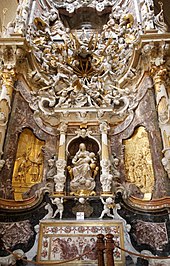El Transparente

El Transparente is a

Its execution was ordered by
According to American writer
Not only was a skylight cut into the top of the thick back wall of the cathedral across the ambulatory behind the high altar, but another hole was cut into the high altar itself to allow the shafts of sunlight to illuminate the tabernacle like a spotlight.
After the two holes were cut, Tomé and his sons designed a way to visually connect the two by sculpting a fantastic company of angels, saints, prophets and cardinals. Abstract designs suggesting flowing robes and foliage hang over corners to mask the details of the architectural piercings. Along the edges of the skylight they arranged an array of Biblical figures who seem to tumble into the cathedral. At the outer edge of the opening sits Christ on a bank of clouds and surrounded by angels. The back side of the altarpiece was converted to a tower of marble which reaches from the floor to the ceiling. Intricate groups of figures were assembled so that the opening to the tabernacle could be hidden yet permit light to pass through.
References
- ^ Narciso Tome's 'Transparente' in the Web Gallery of Art.
